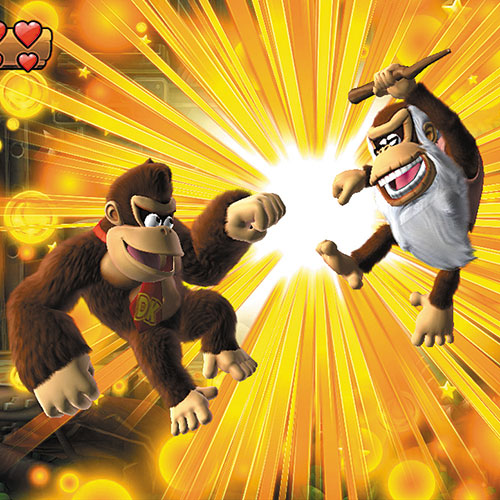‘Tropical Freeze’ shows Donkey Kong is still game

By Todd Martens | Los Angeles Times (MCT)
DONKEY KONG COUNTRY: TROPICAL FREEZE
Platform: Wii U
Publisher: Nintendo
Genre: Platforming
ESRB Rating: E, for Everyone
For the last three decades, one of the video game world’s greatest antiheroes has been a barrel-throwing ape. He’s arrogant, ornery and not nearly as dexterous as he thinks he is. A kidnapper whose jungles were construction sites, he’d steal your girlfriend and trap her atop a skeletal steel structure.
But as males-behaving-badly became a pop-culture norm — and an unfortunate requirement of most video games — Donkey Kong softened up. The once attention-desperate gorilla shed his hostage-taking ways and settled into a more healthful lifestyle with the launch of “Donkey Kong Country” in 1994.
Now five iterations of the game later, he’s morphed into a rather lovable grump who just wants to enjoy a slice of cake with a frosted banana on top in peace.
“Donkey Kong Country: Tropical Freeze,” released for Nintendo’s home console the Wii U, finds the king of the jungle continuing the makeover from villain to reluctant hero. Arctic creatures are invading the lush isles he calls home, and Kong wants the polar beasts off his lawn.
Whereas Donkey Kong once tossed barrels at a portly, blue-collar adventurer — a character who would eventually become known as Mario and would help lead Nintendo into decades of video-game brand dominance — today he faces off against musically-inclined owls, penguins who are experts in archery (they shoot fish, not arrows) and Viking walruses (walrus Vikings?). He may make a mess of things along the way, but it’s up to him to preserve paradise.
While Donkey Kong is jostled out of a vacation-like existence in “Tropical Freeze,” the action-adventure he embarks upon is one readily recognizable to Nintendo fans and players, who guide the ape left-to-right and up-and-down through jungle-inspired mazes, where a barrel roll and a stomp take care of most adversaries.
It’s worlds away from the cartoonish urban setting of the original “Donkey Kong,” which was released in 1981 and predated the Nintendo Entertainment System. It catapulted games into the mainstream cultural conversation, creating a brave new world.
At the start of “Tropical Freeze,” in contrast, a relaxed Donkey Kong is surrounded by pals and enjoying the island life. His birthday is interrupted by a chilly breeze and a snowflake, and a peek out the window reveals that a pack of cold-loving critters, the Snowmads, are threatening to make like Disney’s Queen Elsa and give Kong’s home an icy remodeling.
Whether Donkey Kong actually wants to prevent a cold front from encapsulating his kingdom or is just annoyed that his birthday was interrupted isn’t always clear. After all, the Snowmads largely seem like they’re having a good time and tiny, slow-moving penguins are no match for an angry ape (plus, they’re far cuter than those mutant, bouncing mushrooms of the “Super Mario” series).
It’s easy to be impressed by Kong’s kingdom. Giant glowing mushrooms recall “Alice in Wonderland” and gorilla transportation includes mine cars, log flumes and a rhinoceros. Levels go underwater, careen into caverns and transform as the player moves through them, sometimes being shaped by a giant and deadly sphere of Gouda cheese. Casual gamers will likely kill hours trying to pass even some of the game’s early challenges, but the tone is never less than sprightly, thanks in part to David Wise’s jazzily upbeat and lightly Caribbean score.
Following relatively closely on the heels of the Wii U’s “Super Mario 3D World,” “Donkey Kong Country: Tropical Freeze” is once again an example of Nintendo’s prowess in the run, jump and smash genre of gaming. This isn’t the re-imagining of the former, which saw Mario and Co. gaining the ability to essentially transform into cats and more freely roam the game world. Instead it’s more a refinement of a style, requiring near-precise player reflexes to glide on vines, hop around fragile leafs and ride a mine cart on the wings of crashed safari jets.
Donkey Kong isn’t always the most cooperative of video game characters. Set the controller down for a minute and Donkey Kong will start playing a hand-held video game system. His ultimate goal is relaxation, and the player is pushing and prodding him along like an overbearing personal trainer.
While Donkey Kong can climb up vines and powerfully roll through walls, he’s still a gorilla and isn’t exactly the most sure-footed of characters. Donkey Kong needs a second to slow down, a moment to catch his balance and friends to reach greater heights. This means he will die often.
Compared with the can-do Mario, there’s always the sense that Donkey Kong may just nap if it weren’t for the player. Donkey Kong’s pals liven things up. There’s an elder ape (Cranky Kong) who hops on a cane, and two younger boy/girl tag-alongs, Diddy and Dixie, who use a baseball cap (him) and a lock of blond hair (her) to propel Donkey Kong up into the jungles.
For those who want to get deep into Donkey Kong lore, Cranky Kong is said to be the aging version of the kidnapping ape seen in the original game.
Yet it’s the spunky Dixie, whose hair whips around like helicopter blades as she balances on a spinning Donkey Kong, who delivers the energy and attitude. Maybe that’s because her ponytail and pink beret give her some of the game’s most exaggerated features, or maybe that’s because female characters are still such a rarity that playing one can turn a familiar genre, even a well-made one, into a whole new game.











